Abutilon: description, types, features of planting and reproduction
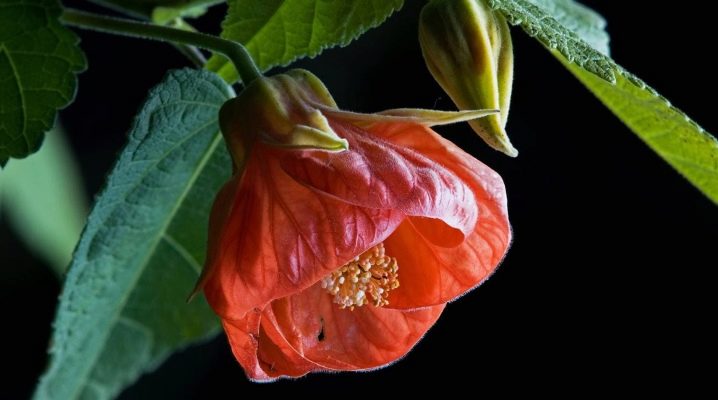
Among the many plants that can be grown in our country in the garden, abutilone deserves attention. This culture can also be used in indoor gardening. But you need to study it very carefully before starting work.
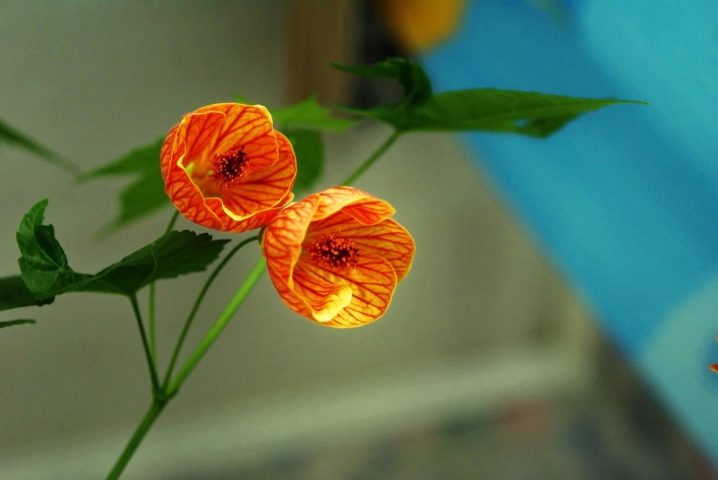
Description
Abutilon is not just one plant species, but a whole genus. It includes semi-shrubs, grasses, and full-fledged shrubs, it can be both perennials and annuals. Literally "abutilon" is translated as "shade-forming". There is also another name for it - "indoor maple", which was given to him because of the characteristic type of foliage. Abutilone fibers are traditionally used in India to make ropes and sometimes sackcloths. Therefore, sometimes abutilon is also called a cable car. The leaves of this plant are quite large (up to 0.1 m long), have 3, 4 or 5 lobes. Abutilon can form flowers:
- red;
- yellow;
- white.
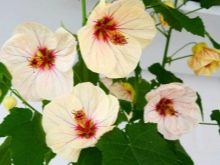
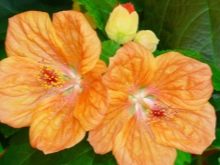
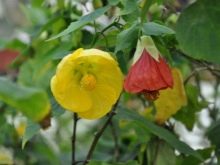
Only a small part of the species of this genus has been introduced into culture. On their basis, a number of "pure" and hybrid varieties have been created. Hybrids are characterized by:
- a wide variety of colors;
- long flowering;
- variety of geometry of flowers, foliage.
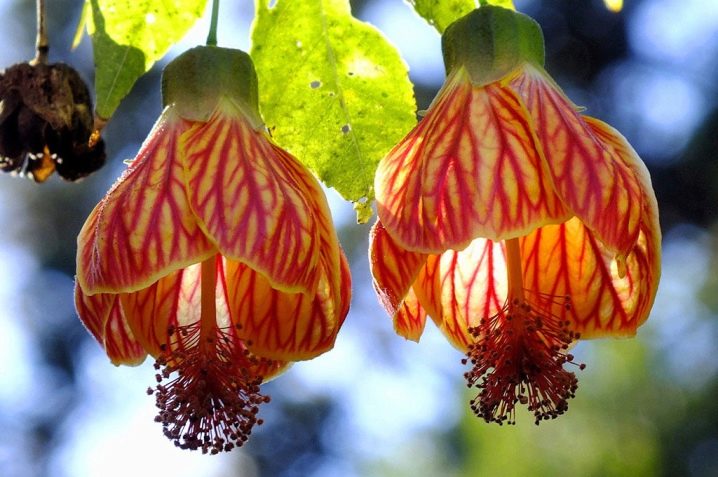
In Russia, the cultivation of abutilon helps to green up rooms and rather large rooms. Due to the special selection of varieties, it is possible to ensure the year-round flowering of the ensemble. Those who wish to obtain an atypical variety experiment with grafting variegated types on specimens with normal leaves. The total number of species is quite large. Depending on the sources, over 100 or even over 400 species are mentioned.


Under natural conditions, abutilone inhabits the tropics and subtropics. Some of the species have even mastered the temperate climatic zone. In Russia and other countries of Eurasia, you can find Theophrastus cable car. It is widely used for fiber production. But not all species in this genus are suitable for this use.
Types and varieties
The attention of many gardeners deservedly attracted a hybrid variety. "Juliet".
The attractiveness of this plant is associated with:
- rapid development;
- unpretentiousness;
- external grace;
- no need for intense backlighting;
- lush flowering.

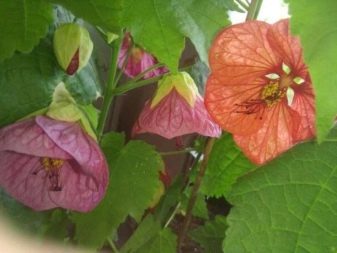
"Juliet" forms large flowers and can grow up to 1.5 m. Over the year, the shoots add an average of 0.5 m. The foliage of this variety can reach 0.15 m in length. It looks like carved around the perimeter and has a thick green color. No wonder it is “Juliet” that I call “indoor maple” more often than other varieties.
If the basic requirements for care are met, then the hybrid grown from the seed will begin to bloom at 4 or 5 months of age. When there is sufficient light, flowering will continue throughout the year. The flowers themselves outwardly resemble a small bell and are oriented downward. The wide part has a diameter of 0.05-0.06 m. A heterogeneous color is quite possible. And pink, and orange, and even bright yellow "Juliet" looks organic.
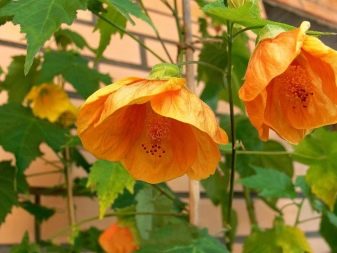
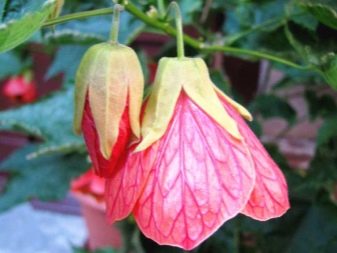
Even more interesting is the result of crossing two colorful shrubs with each other. Intense backlighting is contraindicated for this variety. But if you provide relatively simple care, even beginners can get a brilliant result. Experts advise to select only those Juliet seeds that are covered with a dark shell. Before planting, it is better to soak them in warm water or even in a growth accelerator solution.
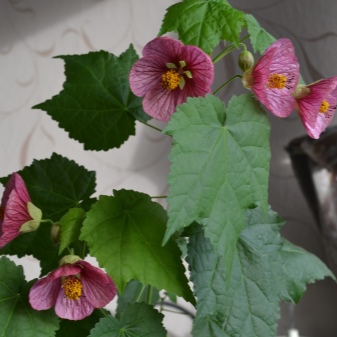

Abutilon "Bella" Is another attractive hybrid that is relatively small in stature. Strictly speaking, this is not just one plant, but a whole group. The advantage of the dwarf crop is that it is very easy to grow at home.
Variety selection "Bella":
- does not exceed 0.3 m;
- forms a highly branching crown;
- blooms for a very long time;
- forms wheel-like flowers.

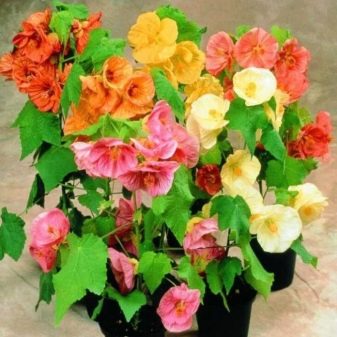
Abutilon of this series, which is important, is minimally demanding to care. Florists will only need to strictly adhere to the simplest requirements. After planting, you will have to wait for shoots for 14-20 days. Flowering usually occurs 6 months after sowing. Bella abutilons cannot grow to more than 0.4 m.
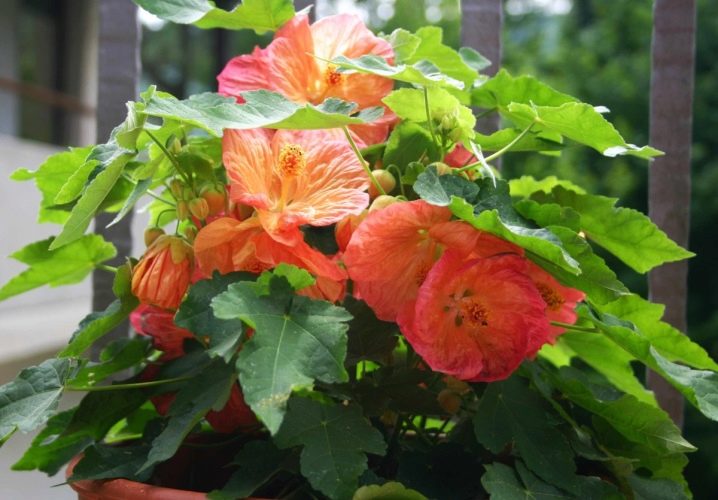
Variety "Salmon Shade" can form a lush crown if you make a systematic pinching. Salmona flowers are painted in a delicate peach tone. The petals are covered with dark streaks. The “yellow” variety grows slightly higher and also requires constant pinching. The flowers take on a pronounced lemon color.
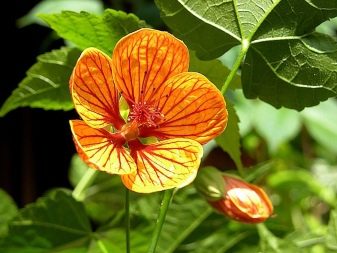

Variety "Pink" famous for its ability to independently form a bush. The flowers are painted in a delicate pink tone. Abutilon "Red" also bushs well and gives large flowers of a thick scarlet hue. "Vanilla" forms a lush crown and forms a mass of pale yellow flowers. There are other varieties in this group, each of which is notable for something.


Megapotamian (aka Amazonian) abutilone differs from other plants of this genus by the atypical appearance of inflorescences. It also blooms profusely. A branchy spreading bush has a crown drooping from above. In the wild, it can grow up to 2.5 m. The lanceolate foliage is darker than usually found in abutilones.


The length of slightly pubescent leaves does not exceed 0.08 m. But it is also important to know about the variegated megapotamian abutilon. Its leaves have a characteristic yellow speck. The result is a pattern like first-class marble. Single small inflorescences grow from elongated pedicels. When the flowers bloom, they appear as bright red lanterns narrowed at the bottom. From the inside, wide petals, similar in color to egg yolk, are visible. They are similar in shape to bells. In turn, a violet-lilac column emerges from the middle of the flower.
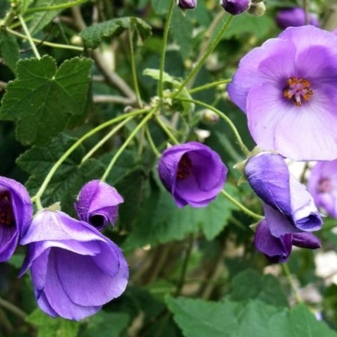
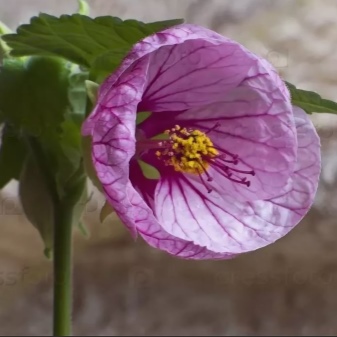
"Amazonian" abutilone is derived from plants found in Argentina, Brazil, Uruguay. Therefore, it is very important for this culture to maintain a warm and humid atmosphere. In warm regions, the variety is very popular and can achieve an impressive effect when landscaping outdoors. You can use this plant in ampel compositions. But in any case, you will have to constantly spray the leaves so that they do not dry out.
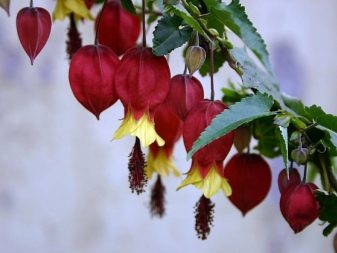
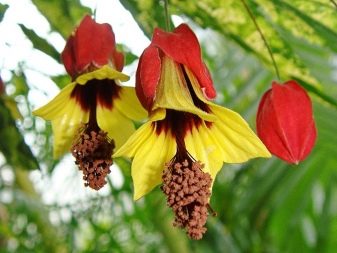
Some growers prefer to grow Organza abutilone. This plant is ideally suited for home culture. Bell-like flowers form on it. They can be placed singly or in pairs. Normally, the flower is drooping, its diameter does not exceed 0.07 m.
Organza flowers have a clearly visible core. Veins are clearly visible on wide petals. Inflorescences are:
- white;
- pink;
- golden;
- orange color.
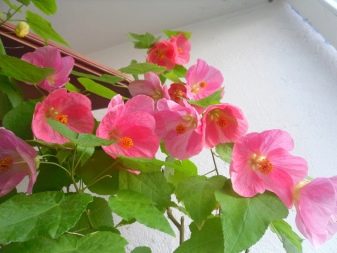
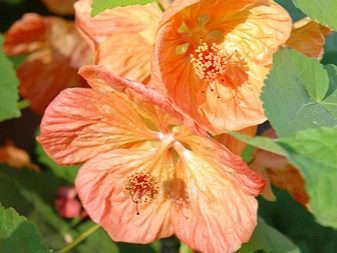
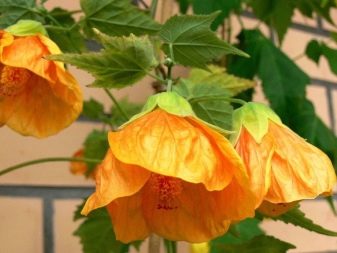
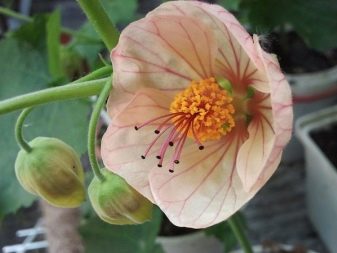
An added beauty is that each of these colors can have varying degrees of brightness. It is not difficult to pick up "Organza" with a very light and concentrated color. Like Juliet, this hybrid is relatively short and can bloom for a long time. The combination of properties makes "Organza" demanded by Russian gardeners and flower growers.
The trunk of a plant can form one or more stems. Its maximum height is 0.6 m. As it matures, the average shoot becomes like a tree, but the branches on the sides remain flexible. The foliage differs from ordinary abutilones in that it is slightly rounded. The leaf is dark green, has rich veins. The wide variety of abutilones made breeders try to combine their traits in one plant. This is how the Bellevue blend was born.The varietal mix is called "beautiful view" for a reason. These are plants that form bells 0.05 m in diameter. At the same time, the main stem is compact, and the distance between internodes is small.
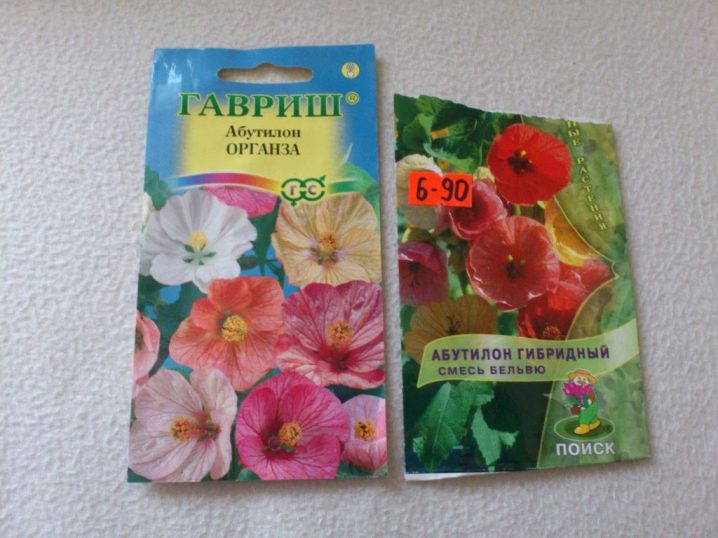
Growers must be prepared that they will not be able to predict the exact color of the Bellevue mix. Different shades of red, yellow and orange can be found, but most often abutilone of the same color grows. Since the petals of the mix are heavy, the inflorescences sometimes hang. The opening of the buds is completely impossible, and even during flowering, the shape of the bell remains unchanged. Abutilone of this group almost does not have to be pinched. Like other members of the genus, "Bellevue" is grown without unnecessary problems. You also need to take care of good lighting.

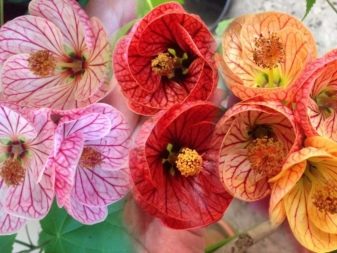
Abutilon "Darwin" has another name, which is less known - Charles's cable car. This variety was introduced into the culture very early. Many hybrids have been created on its basis. Since 2012, botanists consider this plant to be a representative of the genus Callianthe. The Darwin plant forms perennial spreading shrubs. Wild specimens are found only in Brazil. They can grow up to 3 m, but under cultivated conditions do not exceed 1 m. Short hairs develop on the stems. The pubescent foliage is connected with oblong petioles. The leaf blades are very dense, they have hard hairs. Shoots from above look like three lobes. From below, they look more like 5 or 7 blades. Flowers of "Darwin" are large, among them there are both single and grouped by 2 or 3 buds per inflorescence.
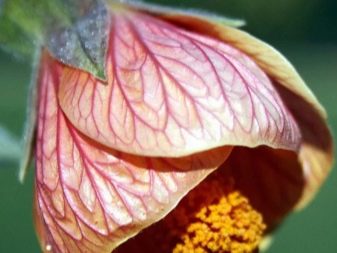
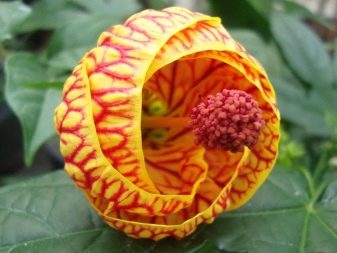
The fruit sometimes contains 10 seeds, but usually there are fewer of them. The plant blooms in pots from April to September. Like other abutilones, Darwin's cable car does not require very difficult maintenance. However, timely pruning is very important. Without it, you cannot achieve a beautiful crown.
"Frozen" is an abutilone with a well-formed bush. Height can vary from 0.3 to 0.5 m. Flowering occurs in moderation, but due to intense lighting, it can be enhanced and extended. The fading parts acquire a colder color, and in the middle part the flower is white or colored in a light pink tone. Dark buds are reminiscent of overripe cherries in tonality. This domestic hybrid was bred quite recently (it has been introduced into cultivation since 2013). The dark crimson petals look very attractive, as do the emerald five-lobed leaves. The length of the leaf ranges from 0.05 to 0.07 m.
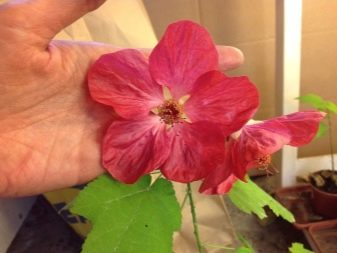
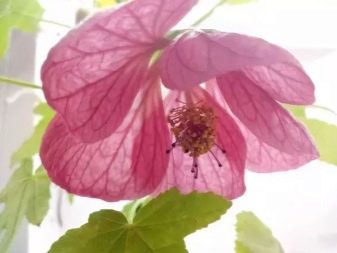
As for the "Vine-leaved" plants, they are spreading bushes up to 1.5 m in height. The stems are erect and have a fairly pronounced edge. The foliage of the "Vine-leaved" abutilon can reach 0.15 m in length. It has a bright green color and is covered with soft villi. This variety blooms in May. Single buds have large blue or lavender corollas. Dark veins run along them, forming a kind of mesh.
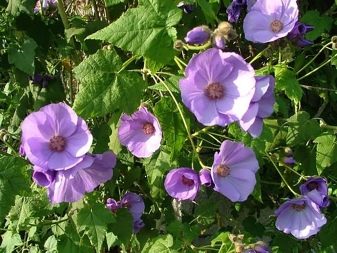

"The little prince" can hardly be called little in fact - in pots, it usually rises to 0.9 m. At the same time, some of the specimens can be compared in height with the "Grape-leaved" variety. Large foliage of bright green color is almost round in shape. Botanists classify it as a five-bladed type. When the "Little Prince" forms bushes, a mass of strong and resilient shoots enters them. From above, they droop, which allows you to form a spreading crown. Flowers also droop, which are up to 0.05 in length and up to 0.07 m in diameter. These golden, white or red bells are decorated with yellow stamens. Flowering lasts from mid-May until about October 15th.
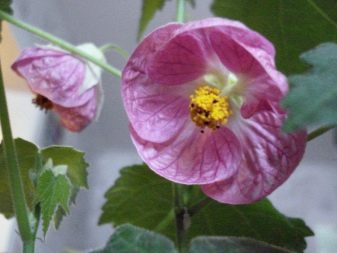

Spotted abutilone forms shrubs with short shoots. They can be soft or partly lignified. Heart-like leaves grow on long cuttings. Finger-lobed foliage is not pubescent, has white spots of uneven color. Spotted abutilon blooms in August and September.
Landing
To successfully grow "Frozen" or any other variety (type) of abutilon, you must first choose the right one. Be sure to take into account all the nuances of the conditions of detention. You cannot buy planting material in unverified places. When the indoor maple has just been brought from the store, it is placed in the light for 2-3 days, and then transplanted into a flower pot. The planting tank should be slightly larger than the shipping pot.
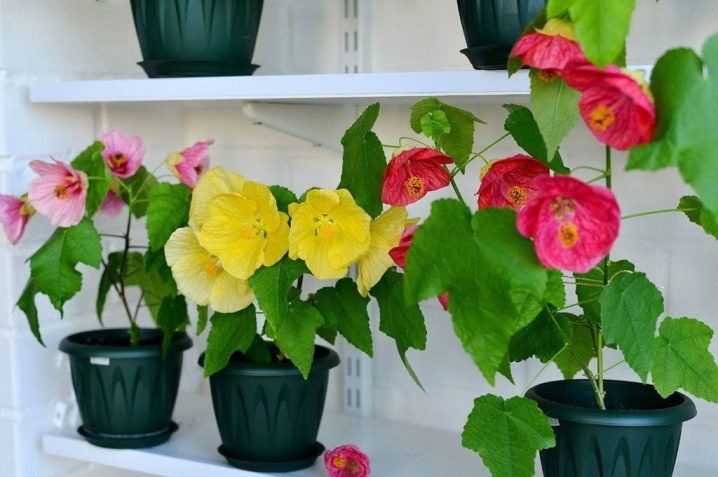
If sowing seeds was chosen, then the grown abutilones must be transplanted into pots one by one or 3-4 pieces. This takes into account the size of the pots and the purpose of the cultivation. Important: rooted cuttings are treated in the same way. Seed-grown specimens can only be planted towards the end of spring. But those that have developed from cuttings are usually planted at the beginning.
The requirements for the soil are not too strict - the main thing is that it is fertile. Usually sod and leafy soil is used, mixed in equal amounts. Instead of sod, coniferous land can be taken. And some growers do it even easier: they take a simple garden soil and add a little humus to it. Use only soil from proven locations that is not contaminated with microscopic organisms or pests. Regardless, the soil needs to be sterilized. They always add to it:
- a small amount of coarse sand;
- coconut substrate;
- peat.
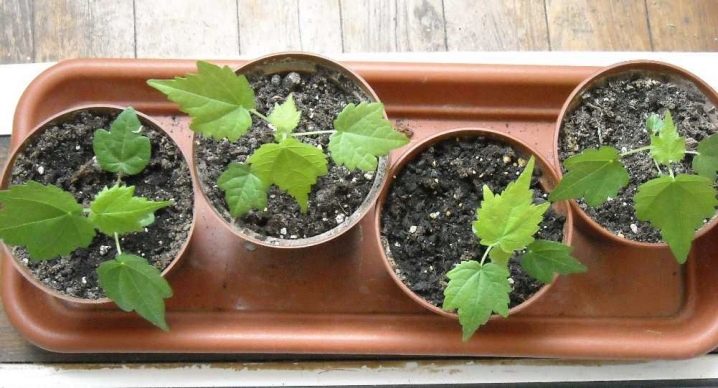
Care
Abutilon at home requires active watering when the heat sets in. In the spring, a radical pruning of the crown is required. It is recommended to place the plant in light partial shade. But if necessary, the "maple" can hold out for several hours in the open sun. During the summer months, the culture is often kept outdoors. However, in this case, it is placed where strong winds do not blow and rain does not pour. In the winter months, the cable car will have to be illuminated. According to experienced florists, it is better to use fluorescent lamps.
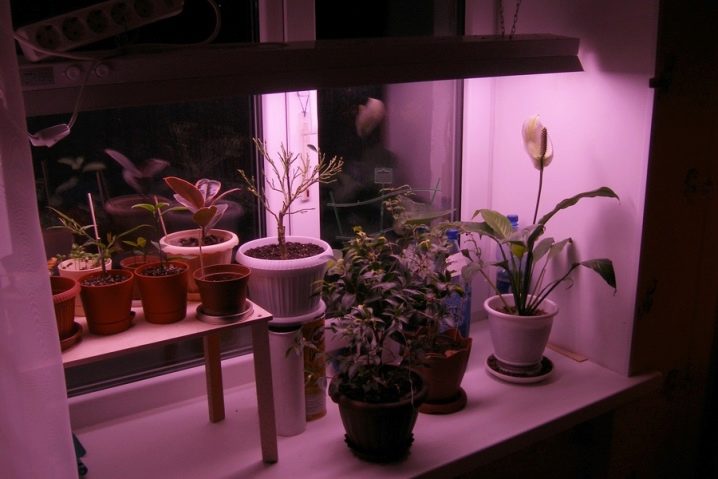
Abutilon will be able to develop at any air humidity. However, in cold weather, if the batteries dry it out, curling and even dropping of leaves can occur. Preventing this is simple: either by rearrangement in a more favorable place, or by daily spraying. Sometimes they put a wet cloth on the radiators. Some growers fill the tray with sphagnum, which is constantly moistened. Indoor maples in the summer months should be at temperatures up to 25 degrees. If it gets hotter, you will have to water the plant more actively.
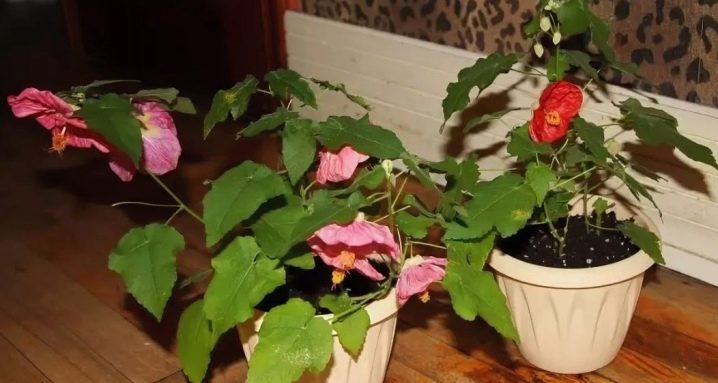
In winter, abutilone should be kept at 12-15 degrees. Overheating of the air can cause foliage to shed. Irrigation should be abundant from March to almost October. Overfilling, like overdrying, can cause leaves to fall off. For a more accurate dosage, water is poured not in one step, but in two - in the morning and in the evenings. It is recommended to mix a small amount of citric acid into the water. Abutilons value slightly acidic earth. In winter, watering should be extremely low. It is necessary to feed the plant from spring to October. At the same time, mineral and organic mixtures alternate.
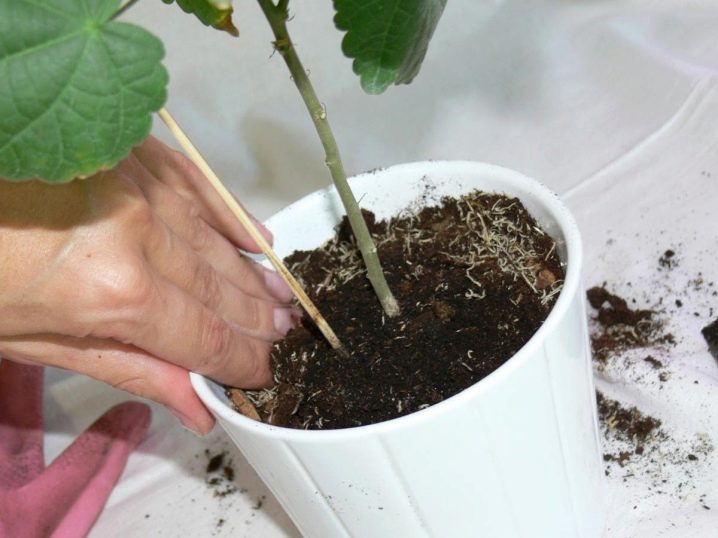
Top dressing should also be done on the leaves. For her, mineral fertilizers are used, which are dissolved to a low concentration. When abutilone is planted or transplanted, you can put rotten compost inside the pot. In this case, organic mixtures are applied after about 6 months. It is very convenient. It is recommended to be guided by your own feelings when caring for abutilon. The optimum air humidity range for this plant is the same as for humans. Therefore, there will be no mistakes. In winter, artificial insolation should bring daylight hours to at least 10 hours a day. During the summer months, it is advised not to expose the plant to the sun for more than 2 hours a day.
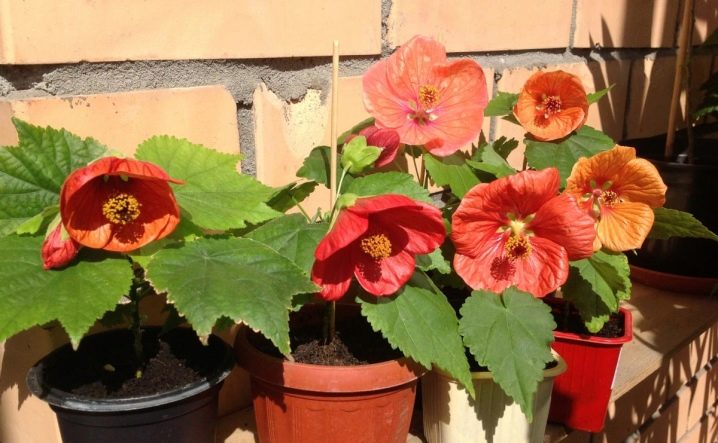
The ideal place for pots is northeast or northwest. If you have to keep the cable car in a room facing only south, it is removed from the window.It is important to monitor the condition of the earth so that it does not dry out excessively. Only water that has passed through a filter or has settled for at least a day can be used for irrigation. Before flowering, complex fertilizers are used on average once every 8 days. As soon as bud tying begins, a special feeding for flowering crops is used. The application mode does not change. In the summer, the intervals between dressings are increased to 14 days. In November and February, fertilizers are applied monthly. Sometimes feeding is stopped altogether to allow the flower to relax.
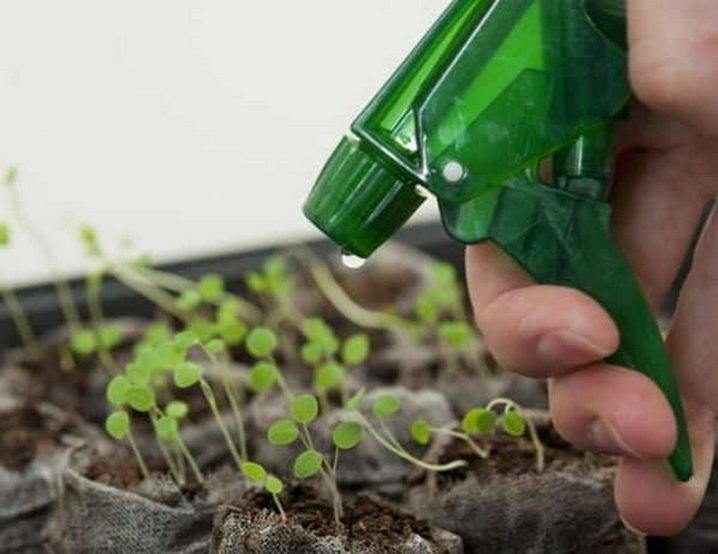
Reproduction methods
It is quite easy to propagate and root abutilone. To do this, use the vegetative method or seeds. Cuttings are cut from the top with a length of 0.1-0.15 m. The buds will have to be cut off. Basically, rooting is done in water. Occasionally, when propagating by cuttings, the planting material is immediately planted in the soil. It is necessary to mix equal volumes of peat and sand when preparing the soil. Additionally, activated carbon is used. A portion of the coal is pre-moistened. Some farmers mix a growth promoter with the water.
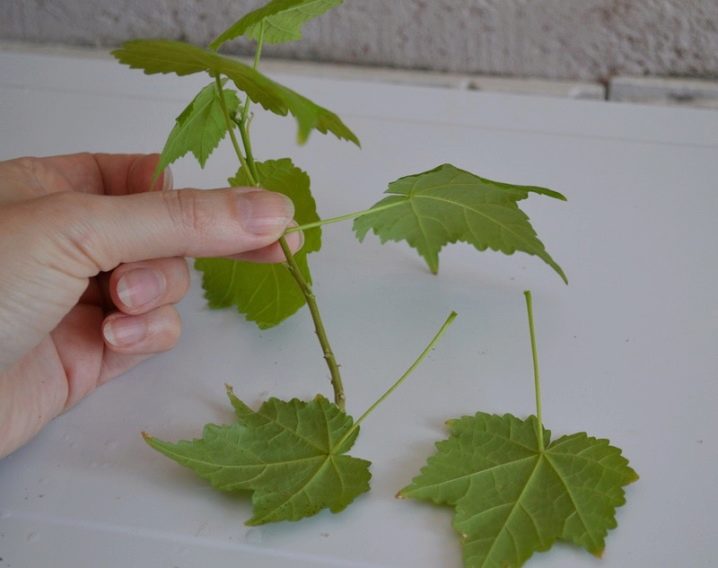
In order for the grafting to be successful, a miniature greenhouse is erected on top. As soon as the roots appear, you can transplant the plants into pots. A similar option is suitable for cultivation in the spring. The seed method is used mainly in winter. If the seeds are sown in January, a flowering plant will be grown by the summer. The problem with the seed method is that it takes a long time to germinate. Even under the most favorable conditions, it will take at least 20 days. And sometimes you have to wait as long as three months. Soaking in warm water for several hours helps. There, the seeds are kept until they swell, and then they are sown on moist soil and sprinkled with earth.
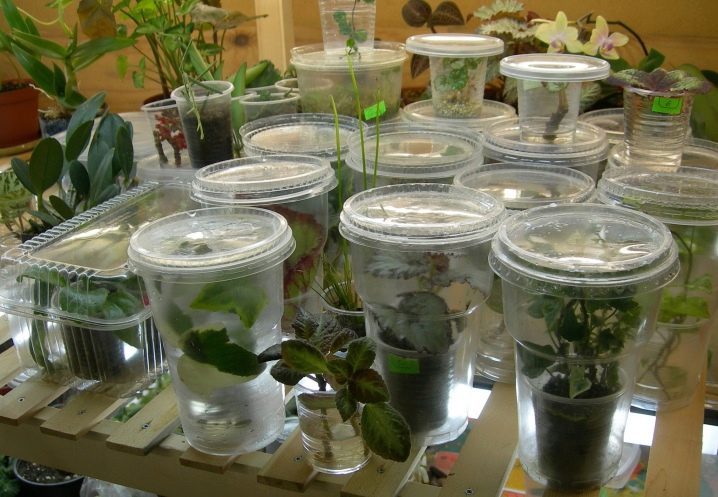
Next, you need to water the plantings. Sometimes containers are covered with plastic wrap or glass. In this case, the plant needs to be ventilated. As soon as shoots appear, the shelter must be removed. The container is placed in a bright place and wait for the end of the emergence of the shoots.
As soon as a couple of real leaves come out - it's time to dive for abutilone. Seating on the pots is done when it reaches a height of 0.05 m. It is not necessary to postpone this manipulation excessively. The roots develop very quickly and will be closely intertwined. A delay in replanting may result in the roots needing to be torn apart. For preliminary germination of seeds, cotton pads or napkins are used. They are laid out in a shallow container and covered with water. Discs and napkins should be completely saturated with water, but should not stagnate at the bottom of the container. It is advised to germinate abutilone with the help of thawed or settled warm water. It is necessary to keep the seeds laid out inside under a film or under a transparent lid.
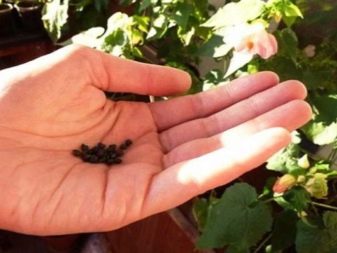
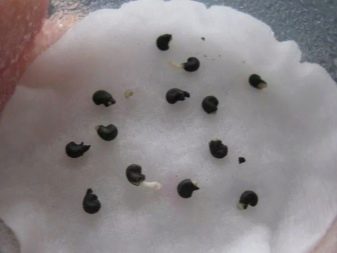
The container should be kept at a temperature of about 25 degrees. The roots should appear in 4-8 days. In the case of planting seeds in peat discs, they should not be deeply buried. It is best if they are covered with only 0.002-0.003 m of soil. The substrate will allow you to acclimatize the planting material in a short time. Cutting is preferable to the seed method, if only because it is possible to preserve all the valuable qualities of the original plant. For novice florists, saving time is also quite valuable. Cuttings must be freed from the lower tier of foliage, from all buds and flowers. You can prevent root rot by adding activated carbon to the water. If not, you can put crushed charcoal.
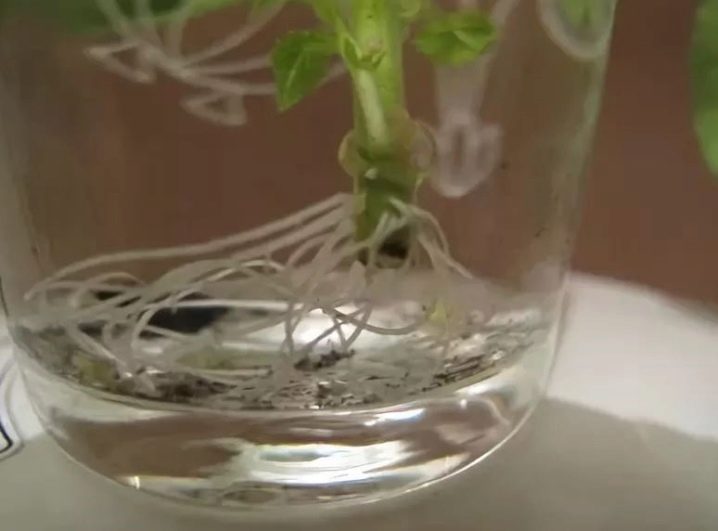
The roots should reach a length of 0.03-0.07 m. Only then is the abutilone transplanted to the final growing site. Young specimens should be planted in pots with a diameter of 0.07 m (sometimes slightly larger). A powerful drainage layer is certainly prepared below. A little bit of soil is poured over it, into which the seedling is carefully moved. Dusting with a wet substrate is done with the utmost care. Otherwise, the fragile root system can be disrupted. Additional soil compaction is not performed.The end of adaptation of the cutting is indicated by the release of young foliage. When the growing season is over, the rooted plant can already be used itself to obtain planting material.

Diseases and pests
The soft foliage of abutilones makes them a desirable target for spider mites and scale insects. If an infection occurs, you will have to use a tobacco solution. Additionally, the leaves are washed with warm soapy suds. Warm water is useful to wash it off. An old remedy such as an infusion of horse sorrel also helps quite well. The same infusion helps to prevent the attack of pests. Healthy abutilones are sprayed every 14 days. If there are a lot of insects or it is not possible to remove them with conventional means, use branded insecticides.
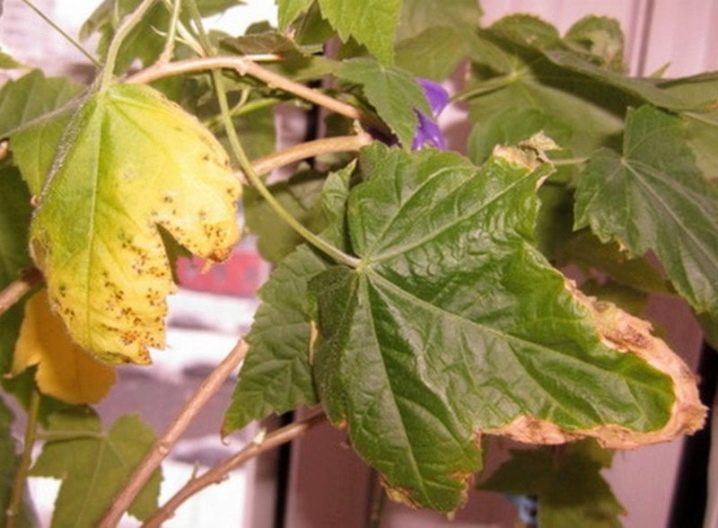
Elongated stems indicate that they lack light. Foliage collapsing means that drafts are blowing over the abutilone or it is supercooled.
Leaf fall is provoked by a lack of water and nutrients. If the leaves are covered with a crunchy brownish border, the soil is drying out. Curled edges are caused by excessive backlighting. Pallor, on the other hand, arises from a lack of light. When the leaves turn yellow, this is due to dry air or intense heat. Florists sometimes use spider mite shampoos for animals. When the leaves are covered with a white bloom on top (gradually turning brown), there is a powdery mildew infection. If the infection intensifies, plaque can be detected on:
- bud;
- stem;
- flowers.
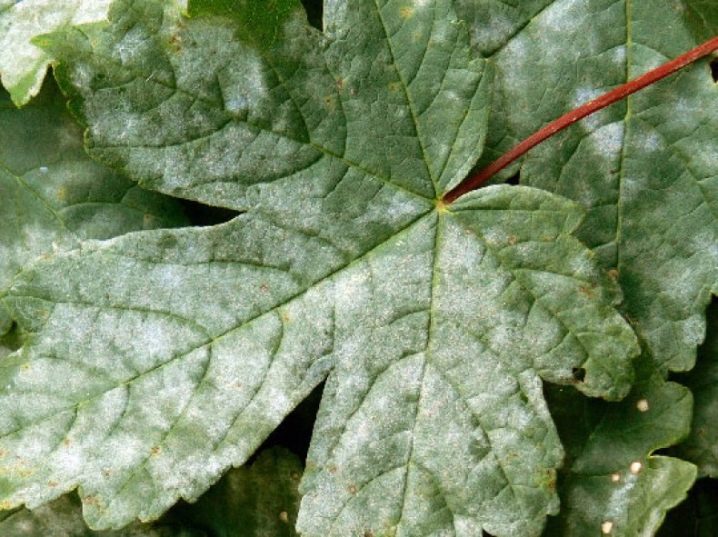
In such cases, diseased leaves are removed. After that, the affected specimens of abutilon are pollinated with sulfur. Of the synthetic drugs, Fundazol and Baycheton are recommended.
Abutilon covered with white midges is affected by the whitefly. You can get rid of aggressive pests with a stream of water, after which a suitable insecticide is applied. After a while, the processing is checked again. Repeated sessions are conducted until they succeed. It is recommended to ventilate the rooms more often, to lower the temperature in the room. The fight against aphids is similar. First, the pests are washed off with water, and then the plant is treated with insecticides. When infected with mealybugs, alcohol is used. It should be applied with a cotton swab. When such processing is done, it is imperative to use branded insecticides. If most of the plant is affected, it will have to be destroyed.

Cyclamen mites gather on leaves from below, and their colonies resemble dust accumulations. But this "dust" destroys leaves and buds. The diseased parts are destroyed. Abutilone itself is washed with insecticidal soap. If the infection is very strong, use Actellic. You can avoid infection with a sooty fungus by fighting other pests. Plaque is removed manually, and then "Decis" or "Karbofos" is used.

To strengthen the immunity of abutilone, it is necessary to fight against a lack of magnesium. This trace element is critical for the plant. Its deficiency manifests itself in the yellowing of the edges of the leaf plate. But nevertheless, the veins and the areas adjacent to them remain green. If there is still not enough magnesium, the sheet rolls down from the edges. It becomes convex, and the tissue dies off. When there is not enough iron, the leaf turns yellow between the veins, and the veins themselves retain their green color. For treatment it is necessary to use "Ferrovit" or the drug "Fe +".
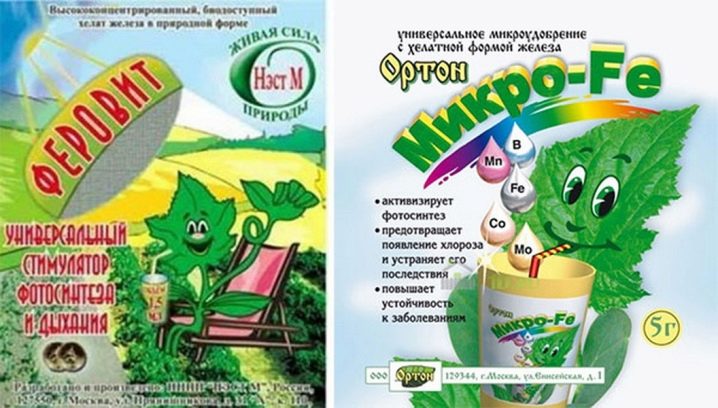
For information on how to properly care for abutilone, see the next video.























The comment was sent successfully.